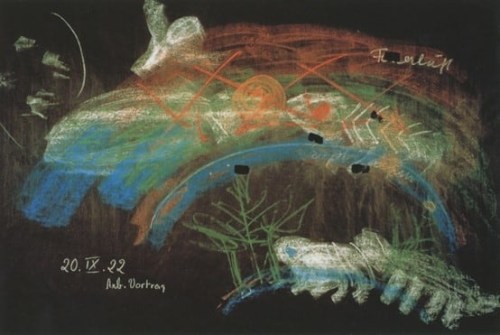
September 20, 1922 (The Earth Was Once a Giant Animal), 1922
Rudolf Steiner
By Michael Brennan
March 18, 1998
Rudolf Steiner was, of all things, a great 20th-century mystic. He claimed to have had clairvoyant powers of perception since childhood, and he later developed his own "supersensible" spiritual science of Anthroposophy after breaking with Theosophists over the recognition of Krishnamurti as the incarnation of a new Christ/messiah figure, among other issues. Incidentally, he left Theosophy the exact same year that the De Stijl painter Piet Mondrian joined.
Steiner, along with the architect Ernst Eisenpreis, built the fabulous Goetheanum in 1924 to be the new society's center. It was "a remarkable building designed architecturally to embody the spiritual secrets of the universe and made of the same combination of woods as violins so that it would vibrate with all the arts." Unfortunately, this beautiful structure was burned down by Steiner's arsonist enemies, who were fearful that he was leading some kind of sympathetic "Jewish-Bolshevik" movement. A second Goethanum was completed in concrete by 1928, and it still stands today in Dornach, Switzerland. This Goethanum is a true masterpiece of 20th-century expressionist architecture that rivals Le Corbusier's sculptural chapel at Ronchamp (which it inspired) and Frank Gehry's recently completed Guggenheim at Bilbao. Steiner died shortly before it was completed.
This exceptional show at Peter Blum is a rare opportunity to see Steiner's famed but forgotten blackboard drawings from the 1920s, which have not previously been shown in the United States. Steiner made the drawings during lectures with colored chalk on black construction paper, which has been saved by his devotees.
Much has been made of the obvious similarity of Steiner's drawings to the blackboard works of Joseph Beuys. Steiner's diagrams probably influenced Beuys; they contain the same imagery, such as the outline of a standing man and sketchy representations of the solar system. Three things should be noted, however. Artists ranging from Paul Klee to Cy Twombly and Per Kirkeby have also experimented with the familiar pedagogical device of the chalkboard, though all towards different ends. The medium has an immediate and inescapable beauty. Furthermore, I'm certain that Steiner, whose lasting legacy as an educator is demonstrated by the many Waldorf/Steiner schools around the world, would have encouraged his students to use this technique to render what are extremely esoteric ideas in a more easily communicable form.
Secondly, the works that Steiner actually produced as art were either derivative German Expressionistic sculptures (resembling the malformed if stirring Lady of Liberty statue from China's Tianammen Square) or wispy, mystical color-aura pastels. Neither of these bodies of work have had any substantial impact, even though they were born from the same man, through the same ideas. Lastly, it seems certain that any German consciously channeling the same quasi-mystical tendencies of Goethe or Hegel would arrive at much of the same arcane, Sigfriedian imagery. The dirty little secret of modernism is that although it supposedly extinguished all forms of metaphysics, many of its greatest practitioners (including Mondrian and Louis Kahn) had mystical tendencies.
Steiner's mysticism is beautifully illustrated in this show at Peter Blum. The drawings, which correspond to lectures with titles like "The Earth Was Once a Giant Animal" or "A Kind of Breathing in the Light," all have an undeniable incandescent and schematic charm. The iconography dispensed by Steiner is more immediately engaging and original than much of the deliberately misleading imagery found in contemporary art. The "create your own universe" style that was valorized in the last Whitney Biennial, in particular, used mystical imagery to veil what was meaningless or trivial -- quite different from Steiner's attempt to expand knowledge towards useful and positive ends.
With their fire-into-light elemental qualities, these energetic drawings easily convey Steiner's Promethean spirit. This show, subtitled "Knowledge of Higher Worlds," was the hit of the winter season in New York, largely because it revealed the great potential of personal cosmology applied to esthetic ends.
Rudolf Steiner, "Blackboard Drawings, 1919-1924," Feb. 7-Mar. 21, 1998, at Peter Blum, 99 Wooster Street, New York, N.Y.
MICHAEL BRENNAN is a New York painter who writes on art.